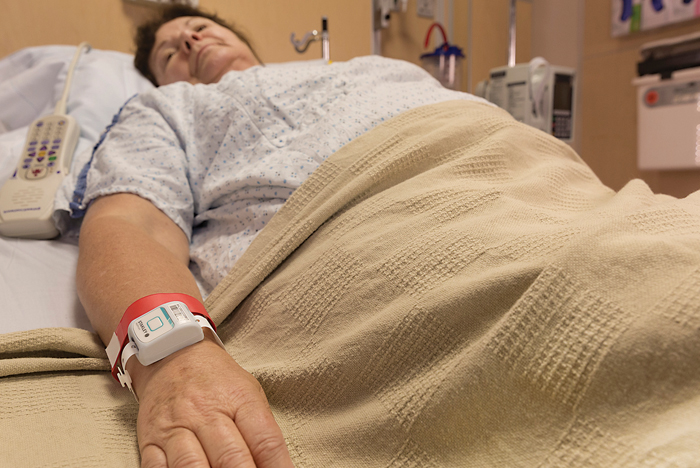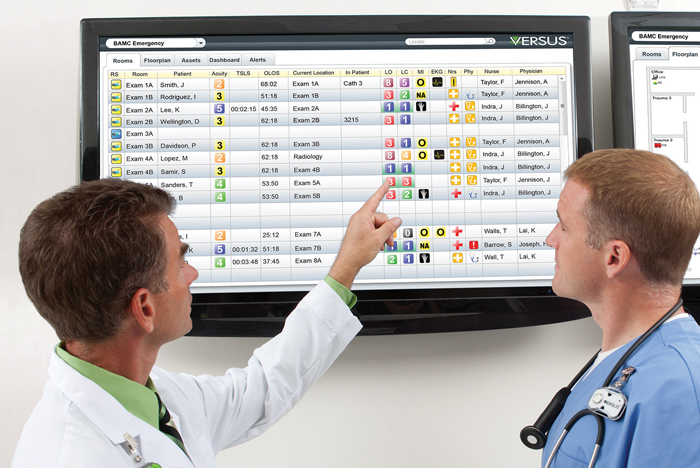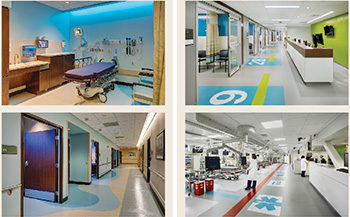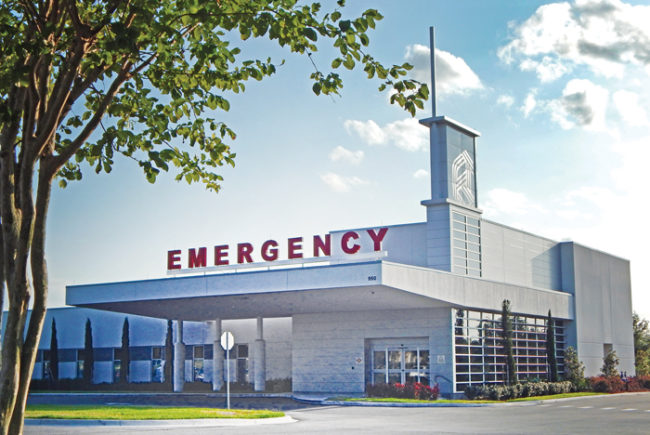
Playing Tag: By applying transmitter tags to patients, administrators can access accurate and actionable real-time data regarding their precise locations and statuses.
Image courtesy of Stanley healthcare
The emergency department (ED) often is the face of the hospital and the location where the majority of inpatient admissions occur. When the ED is efficient, it improves performance and drives patient satisfaction for the entire hospital stay.
A positive ED experience creates a more positive stay overall and improved patient satisfaction scores. Poor HCAHPS ratings are broadly seen on the internet and can have negative financial impact.
In addition to clinical operations, both the physical design of an ED and technologies that are adopted can have dramatic impacts on patient flow, satisfaction and safety. Technologies used in efficient EDs include, but are not limited to, patient tracking boards, registration kiosks and real-time patient locating systems.
Inefficient flow in the ED results in patients who leave without being seen and patient boarding, defined as a patient who remains in the ED after he or she has been admitted to the facility but has not been transferred to an inpatient unit.
ED architecture
It is important that facilities managers work with architects to maximize line-of-sight between the staff and patients as well as visitors in the ED waiting areas. Providing a transparent boundary between the ED proper and the waiting area is one of the many strategies that design teams may utilize.
Additionally, having this line-of-sight boundary near a nurses’ station or other area that sees an uptick of clinical staff traffic, such as the postanesthesia care unit, will increase patient and visitor monitoring.
With the exception of high-acuity rooms, such as trauma and resuscitation rooms, the typical ED treatment room is between 140 and 160 square feet. Many of these rooms now incorporate glass front walls, which allow for a quiet patient care environment, but also allow for full patient monitoring.
When designing basic structural elements, the project team should keep hard-wall elements, like stairwells, in a centralized support core, rather than injected into the patient room layouts. This design will capitalize on the ability to view treatment areas directly.
More progressive designs implemented by project teams include specialty-designed units for behavioral care. A secure holding treatment room or group of rooms (e.g., pods) are specifically designed to treat patients with primary or secondary behavioral health diagnoses. These rooms and the furniture contained within them are designed with patient safety as the principal concern. The ideal location for behavioral care rooms or pods is on the outside perimeter of the ED and should be somewhat isolated from the other patient care areas of the ED.
EDs are also utilizing the direct-rooming or immediate-bedding concept. In this process, a patient goes through a quick triage and registration process before being transferred to the appropriate treatment room. Once transferred, the remainder of the triage and registration process is completed. This concept allows the patient to remain in the same room for the entire course of care, leaving only for specialized studies or if inpatient admission is required. When there are no beds immediately available, the usual process switches to the team triage concept until beds become available again.
“Treating in triage” is becoming a more common practice in many EDs. This concept can have many names, including “rapid triage and treatment.” However, the general theme is the same — to treat patients more efficiently and quickly, reserving a more traditional ED room for higher-acuity patients. These programs work well in EDs with a minimum volume of 15,000 or more patients annually, along with an emergency severity index (ESI) of 4 or 5. These ESIs designate patients who usually require minimal imaging or laboratory testing. This model requires a provider in triage, either a licensed physician or a physician extender, such as a physician assistant or nurse practitioner.
Use of technology
Technology in the ED can increase throughput, efficiency and patient satisfaction. Devices and systems — from patient tracking, wayfinding and communication systems to increasingly common diagnostic tools — should be top of mind for administrators, physicians and facilities managers. Some of these include:
- Self-registration kiosks. Although they are gaining popularity throughout society, self-registration kiosks still are not widely adopted in EDs, because individuals who are ill desire personal interactions. These kiosks, similar to those utilized in airports and in commerce, are interactive computer stations designed to assist with self-service tasks, including patient check-in, collection of co-pays and other registration functions. Many hospitals use the kiosks to assist in the marketing of hospital and system programs, including smoking cessation and weight management. Hospitals have reported improved registration efficiency when a kiosk is used for basic self-registration. Hospital systems implementing self-registration kiosks report improved patient satisfaction and decreased waiting times, but note minimal-to-no staffing reductions. Thus, there is little financial benefit to kiosk implementation. Vendors usually recommend adding one kiosk for every 25,000 annual ED visits. Space consideration must be given to allow for patient privacy and HIPAA compliance.
-
Real-time locating systems (RTLSs). These systems are quickly gaining acceptance in busier EDs throughout the country. Their benefits include improved patient flow, enhanced patient throughput, decreased treatment room-turnover times, improved patient satisfaction, improved caregiver communication and optimized staffing. By applying a transmitter tag to patients, staff, beds and critical equipment, administrators can access accurate and actionable real-time data as to the precise location and status of patients. This system replaces the traditional whiteboard system previously used to track patients’ movements throughout their ED stay. The RTLS is commonly integrated with an electronic bed board system to allow for easy visualization of the patient’s location, as well as the ability to tag the patient with status indicators such as “lab results pending” or “awaiting discharge.” In addition to using the RTLS for immediate decision-making, long-term data are obtained easily for planning purposes and to document efficiencies when process changes are made. The charge nurse can monitor room and staff status from his or her computer station, eliminating the need to do a walking survey or paging caregivers. Patients arriving via emergency medical services can be preassigned to a room. Other hospital staff, such as social workers, laboratory personnel and respiratory therapists, can locate a patient easily without interrupting other caregivers.
-
Wireless phones. The use of wireless phones is widespread throughout hospitals and especially useful in high-acuity areas like the ED. Besides allowing caregiver-to-caregiver communications in any area of the hospital, wireless phones can be programmed to receive patient alarm notifications directly, view electrocardiography waveforms and receive HIPAA-compliant text messages, including patient-arrival notifications and critical lab results. They also help to reduce alarm fatigue. These devices have the potential to dramatically improve processes and efficiencies. Health facilities professionals need to ensure that the facility’s wireless infrastructure is robust enough to allow for continuous coverage and seamless access-point handoffs. With the increasing utilization of ED resources and the pressures to continually do more with less, it is essential for hospitals to improve processes to become as patient-friendly and efficient as possible. The use of technology assists the hospital in achieving efficiencies by providing data to drive Lean planning. Much of the technology referred to in this article, in particular RTLS, supplies the data needed to make these hard decisions, which affect everything from staffing to patient outcomes.
- Diagnostic equipment. Sophisticated imaging studies are becoming the standard diagnostic tools in the practice of emergency medicine. Most new or renovated EDs now have a computed tomography (CT) scanner either in or immediately adjacent to the ED space. It is also common to have ceiling-mounted, digital radiographic equipment in the trauma rooms, and a separate digital radiography room for routine chest films and fracture studies located within the ED suite. Patient turnaround time increases dramatically when a patient requires transport to the imaging department. Transport also requires removing the patient from a controlled-treatment environment with all needed equipment to an area with minimal medical supplies and support. If the patient is critical and requires a CT scan, an ED nurse and possibly a respiratory therapist will be required to accompany the patient, thereby removing key caregivers from the ED.
Many factors must be explored and analyzed to develop a cost-effective solution to meet the needs of emergency diagnostic imaging. These can include the total ED volume, imaging studies ordered by the ED, capital and operational costs, including the staffing of the imaging rooms, and utilization of the non-ED imaging suite. From a construction or renovation focus, imaging equipment like CT scanners require specialized electrical, shielding, cooling and space considerations. Adequate space also should be given for multiple picture archiving systems. Health facilities managers and designers should consult with their state departments of health as well as the American College of Radiology to ensure that all regulatory requirements are being met.

Keeping Track: Data such as patient location, length of stay and alone/wait time can be tracked and displayed by RTLS software.
Image courtesy of Midmark-Versus RTLS
ED laboratory instruments can be classified as either point of care (POC) or near POC. True POC testing is usually defined as testing done by an instrument that is handheld, such as a blood-glucose monitor. Near POC is an instrument that is commonly operated by laboratory staff and has the ability to perform multiple and more complex studies.
If multiple desktop instruments near POC stations are located in the ED, a separate room with adequate lighting, sinks and multiple emergency power electrical outlets and data-line drops is required. Studies have shown that POC and near-POC laboratory instruments in the ED improve turnaround time. The cost per study increases significantly. Historically, more than 75 percent of all ED patients receive a minimum of one laboratory study. The benefits of improved efficiencies, patient and staff satisfaction, and enhanced patient outcomes far outweigh the increased costs.
Improving satisfaction scores
Design and technology are helping to improve HCAHPS scores through improved patient flow, timeliness of caregiver-to-patient communication, and efficient delivery of imaging and laboratory results.
Implementing or upgrading a health care facility can be costly. However, the failure to update and improve systems can cause a hospital to become less efficient, lowering satisfaction and affecting safety.
Marc Schlessinger, RRT, MBA, FACHE, is a senior associate in Plymouth Meeting, Pa.-based ECRI Institute’s Applied Solutions Group. His email is mschlessinger@ecri.org.





